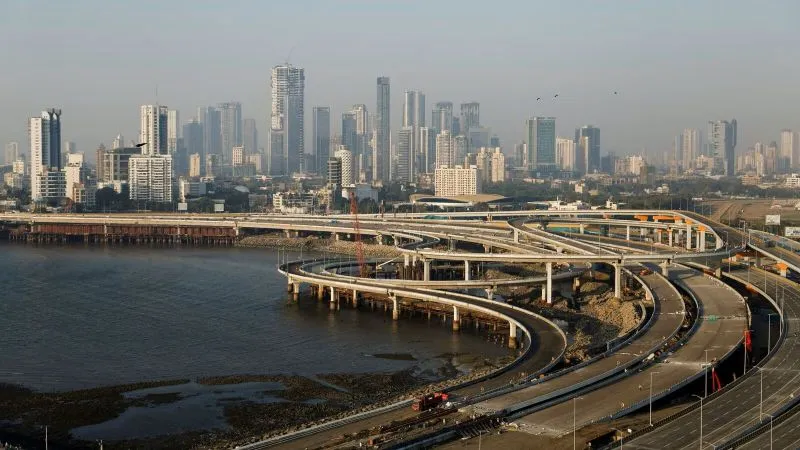Share This Article
- Introduction to the Mumbai Coastal Road Project
- Engineering Marvels: Undersea Tunnel and Promenade
- Project Origins and Planning
- Overcoming Challenges: Environmental Regulations and Land Reclamation
- Architects’ Engagement: Societal Welfare & Collective Action
- Infrastructure and Sustainability: Green Spaces and Flood Mitigation
- Key Features: Bus Bays, Parking Facilities, and Twin Tunnels
- Anticipated Benefits: Efficiency, Sustainability, and Economic Growth
- Conclusion: The Coastal Road as a Catalyst for Progress
Mumbai, often hailed as the city of dreams, is also notorious for its bustling traffic and congested roads. However, amidst this chaos, a beacon of hope emerges in the form of the Mumbai Coastal Road Project. This ambitious endeavour is set to redefine intra-city travel, offering a seamless journey across the miles of the bustling metropolis.
Introduction to the Mumbai Coastal Road Project
The Coastal Road Project is a monumental infrastructure initiative aimed at creating an eight-lane, signal-free expressway that will link Marine Drive in South Mumbai to the northern suburb of Kandivali, covering a total distance of 29.2 kilometres. Phase 1 of this transformative project spans a 10.58-kilometer stretch, connecting Marine Drive to the Bandra-Worli Sea Link, a crucial artery in Mumbai’s transportation network.

Engineering Marvels: Undersea Tunnel and Promenade
One of the most remarkable features of the Coastal Road Project is the inclusion of the country’s first undersea tunnel, stretching an impressive 2.72 kilometres. This engineering marvel not only showcases India’s prowess in infrastructure development but also promises to revolutionize commuting in Mumbai. The journey along the Coastal Road promises to be nothing short of spectacular. From the Princess Street flyover to the Worli end of the Bandra-Worli Sea Link, travellers can expect a significant reduction in travel time, from a staggering 40 minutes to a mere 10 minutes.

This drastic improvement in connectivity is poised to enhance the quality of life for millions of Mumbai residents and commuters. Behind the scenes, extensive civil works are underway to bring this vision to life. The northbound carriageway, which includes the undersea tunnel, promenade, and underground car parks, is nearing completion, with an expected finish date in May.
Project Origins and Planning
The inception of the Mumbai Coastal Road Project traces back to meticulous planning and strategic foresight. Initially proposed as an alternative to the Western Freeway, the project garnered momentum under the leadership of Maharashtra Chief Minister Prithviraj Chavan in 2011. A Joint Technical Committee was formed to study the feasibility of constructing a coastal road, ultimately recommending a 35.6-kilometer freeway to alleviate traffic congestion.

Overcoming Challenges: Environmental Regulations and Land Reclamation
However, the project faced its fair share of challenges, particularly concerning environmental regulations. Coastal Regulation Zone norms in India prohibit land reclamation, necessitating amendments to accommodate the construction of the Coastal Road. Despite concerns raised by environmentalists, the project received clearance from the Union Ministry of Environment and Forests in June 2015, paving the way for its implementation.
Architects’ Engagement: Societal Welfare & Collective Action
This project serves as a lens through which the multifaceted engagement of architects with large-scale urban developments is explored. Architects, both as professionals and citizens, navigate complex dynamics, balancing their individual agency with collective action. The pivotal role of architects in advocating for societal welfare and the significance of organized collective action in effecting positive change in urban development projects are underscored in the examination of the Mumbai Coastal Road Project (MCRP). The project emphasizes the varying degrees of influence architects wield in shaping urban landscapes.

Infrastructure and Sustainability: Green Spaces and Flood Mitigation
The design and execution of the Coastal Road Project reflect a harmonious balance between infrastructure development and environmental sustainability. Extensive land reclamation efforts have reclaimed 111 hectares of land from the sea, with a significant portion allocated for green spaces and recreational amenities. A 7.47-kilometre promenade, twice the length of Marine Drive, offers pedestrians a scenic pathway along the coastline, complemented by parks, gardens, and cycling tracks.
Key Features: Bus Bays, Parking Facilities, and Twin Tunnels
Key infrastructure elements, such as a high seawall and floodgates, have been meticulously incorporated to mitigate the risk of flooding and ensure the road’s resilience against natural calamities. Additionally, provisions for bus bays and underground parking facilities cater to the needs of public transport users and private vehicle owners alike, further enhancing the road’s accessibility and convenience. Central to the project’s success is the construction of twin tunnels, spanning over two kilometres and passing under the Arabian Sea. Equipped with state-of-the-art ventilation systems and fire protection measures, these tunnels exemplify modern engineering ingenuity while ensuring passenger safety and comfort.
Anticipated Benefits: Efficiency, Sustainability, and Economic Growth
As Mumbai gears up to embrace the completion of Phase 1 of the Coastal Road Project, the city stands on the brink of a transportation revolution. The anticipated reduction in travel time, fuel consumption, and carbon emissions heralds a new era of efficiency and sustainability in urban mobility. Moreover, the project’s overarching goal of decongesting existing roads and fostering economic growth underscores its significance as a catalyst for progress.
Conclusion: The Coastal Road as a Catalyst for Progress

In conclusion, the Mumbai Coastal Road Project represents a testament to the power of visionary infrastructure planning and collaborative effort. By seamlessly connecting disparate parts of the city and unlocking its potential for growth, this transformative initiative is poised to leave an indelible mark on Mumbai’s landscape and its residents’ lives. As the city embarks on this journey towards enhanced connectivity and prosperity, the Coastal Road stands as a symbol of Mumbai’s relentless pursuit of progress.

Sources
- https://www.architecturaldigest.in/story/ad100-architects-on-how-mumbais-coastal-road-project-can-be-made-better-for-the-people/
- https://architecture.live/the-mumbai-coastal-road-the-architects-agency-in-engaging-with-a-large-scale-development-project-in-the-city-mrinalini-ghadiok/


